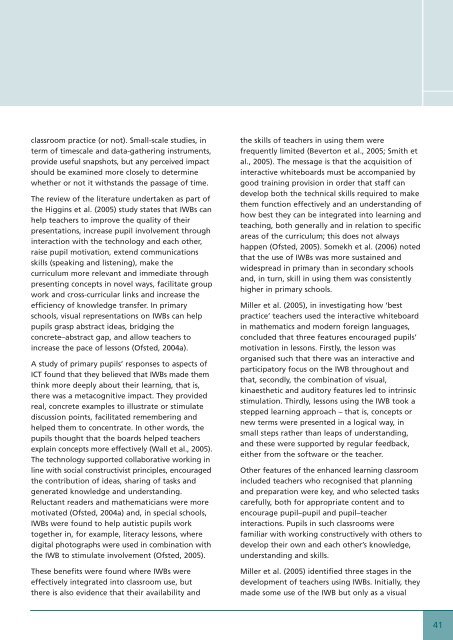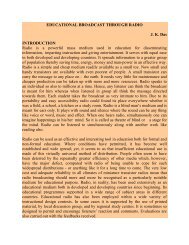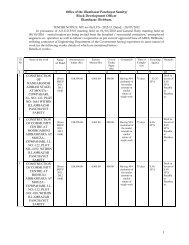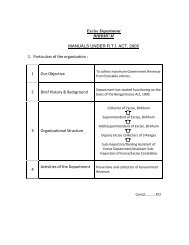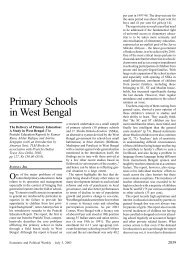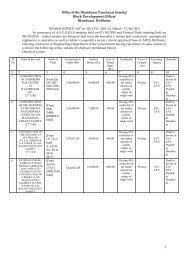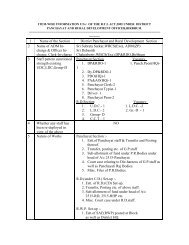The impact of ICT in schools - a landscape review - nationalarchives ...
The impact of ICT in schools - a landscape review - nationalarchives ...
The impact of ICT in schools - a landscape review - nationalarchives ...
You also want an ePaper? Increase the reach of your titles
YUMPU automatically turns print PDFs into web optimized ePapers that Google loves.
classroom practice (or not). Small-scale studies, <strong>in</strong><br />
term <strong>of</strong> timescale and data-gather<strong>in</strong>g <strong>in</strong>struments,<br />
provide useful snapshots, but any perceived <strong>impact</strong><br />
should be exam<strong>in</strong>ed more closely to determ<strong>in</strong>e<br />
whether or not it withstands the passage <strong>of</strong> time.<br />
<strong>The</strong> <strong>review</strong> <strong>of</strong> the literature undertaken as part <strong>of</strong><br />
the Higg<strong>in</strong>s et al. (2005) study states that IWBs can<br />
help teachers to improve the quality <strong>of</strong> their<br />
presentations, <strong>in</strong>crease pupil <strong>in</strong>volvement through<br />
<strong>in</strong>teraction with the technology and each other,<br />
raise pupil motivation, extend communications<br />
skills (speak<strong>in</strong>g and listen<strong>in</strong>g), make the<br />
curriculum more relevant and immediate through<br />
present<strong>in</strong>g concepts <strong>in</strong> novel ways, facilitate group<br />
work and cross-curricular l<strong>in</strong>ks and <strong>in</strong>crease the<br />
efficiency <strong>of</strong> knowledge transfer. In primary<br />
<strong>schools</strong>, visual representations on IWBs can help<br />
pupils grasp abstract ideas, bridg<strong>in</strong>g the<br />
concrete–abstract gap, and allow teachers to<br />
<strong>in</strong>crease the pace <strong>of</strong> lessons (Ofsted, 2004a).<br />
A study <strong>of</strong> primary pupils’ responses to aspects <strong>of</strong><br />
<strong>ICT</strong> found that they believed that IWBs made them<br />
th<strong>in</strong>k more deeply about their learn<strong>in</strong>g, that is,<br />
there was a metacognitive <strong>impact</strong>. <strong>The</strong>y provided<br />
real, concrete examples to illustrate or stimulate<br />
discussion po<strong>in</strong>ts, facilitated remember<strong>in</strong>g and<br />
helped them to concentrate. In other words, the<br />
pupils thought that the boards helped teachers<br />
expla<strong>in</strong> concepts more effectively (Wall et al., 2005).<br />
<strong>The</strong> technology supported collaborative work<strong>in</strong>g <strong>in</strong><br />
l<strong>in</strong>e with social constructivist pr<strong>in</strong>ciples, encouraged<br />
the contribution <strong>of</strong> ideas, shar<strong>in</strong>g <strong>of</strong> tasks and<br />
generated knowledge and understand<strong>in</strong>g.<br />
Reluctant readers and mathematicians were more<br />
motivated (Ofsted, 2004a) and, <strong>in</strong> special <strong>schools</strong>,<br />
IWBs were found to help autistic pupils work<br />
together <strong>in</strong>, for example, literacy lessons, where<br />
digital photographs were used <strong>in</strong> comb<strong>in</strong>ation with<br />
the IWB to stimulate <strong>in</strong>volvement (Ofsted, 2005).<br />
<strong>The</strong>se benefits were found where IWBs were<br />
effectively <strong>in</strong>tegrated <strong>in</strong>to classroom use, but<br />
there is also evidence that their availability and<br />
the skills <strong>of</strong> teachers <strong>in</strong> us<strong>in</strong>g them were<br />
frequently limited (Beverton et al., 2005; Smith et<br />
al., 2005). <strong>The</strong> message is that the acquisition <strong>of</strong><br />
<strong>in</strong>teractive whiteboards must be accompanied by<br />
good tra<strong>in</strong><strong>in</strong>g provision <strong>in</strong> order that staff can<br />
develop both the technical skills required to make<br />
them function effectively and an understand<strong>in</strong>g <strong>of</strong><br />
how best they can be <strong>in</strong>tegrated <strong>in</strong>to learn<strong>in</strong>g and<br />
teach<strong>in</strong>g, both generally and <strong>in</strong> relation to specific<br />
areas <strong>of</strong> the curriculum; this does not always<br />
happen (Ofsted, 2005). Somekh et al. (2006) noted<br />
that the use <strong>of</strong> IWBs was more susta<strong>in</strong>ed and<br />
widespread <strong>in</strong> primary than <strong>in</strong> secondary <strong>schools</strong><br />
and, <strong>in</strong> turn, skill <strong>in</strong> us<strong>in</strong>g them was consistently<br />
higher <strong>in</strong> primary <strong>schools</strong>.<br />
Miller et al. (2005), <strong>in</strong> <strong>in</strong>vestigat<strong>in</strong>g how ‘best<br />
practice’ teachers used the <strong>in</strong>teractive whiteboard<br />
<strong>in</strong> mathematics and modern foreign languages,<br />
concluded that three features encouraged pupils’<br />
motivation <strong>in</strong> lessons. Firstly, the lesson was<br />
organised such that there was an <strong>in</strong>teractive and<br />
participatory focus on the IWB throughout and<br />
that, secondly, the comb<strong>in</strong>ation <strong>of</strong> visual,<br />
k<strong>in</strong>aesthetic and auditory features led to <strong>in</strong>tr<strong>in</strong>sic<br />
stimulation. Thirdly, lessons us<strong>in</strong>g the IWB took a<br />
stepped learn<strong>in</strong>g approach – that is, concepts or<br />
new terms were presented <strong>in</strong> a logical way, <strong>in</strong><br />
small steps rather than leaps <strong>of</strong> understand<strong>in</strong>g,<br />
and these were supported by regular feedback,<br />
either from the s<strong>of</strong>tware or the teacher.<br />
Other features <strong>of</strong> the enhanced learn<strong>in</strong>g classroom<br />
<strong>in</strong>cluded teachers who recognised that plann<strong>in</strong>g<br />
and preparation were key, and who selected tasks<br />
carefully, both for appropriate content and to<br />
encourage pupil–pupil and pupil–teacher<br />
<strong>in</strong>teractions. Pupils <strong>in</strong> such classrooms were<br />
familiar with work<strong>in</strong>g constructively with others to<br />
develop their own and each other’s knowledge,<br />
understand<strong>in</strong>g and skills.<br />
Miller et al. (2005) identified three stages <strong>in</strong> the<br />
development <strong>of</strong> teachers us<strong>in</strong>g IWBs. Initially, they<br />
made some use <strong>of</strong> the IWB but only as a visual<br />
41


